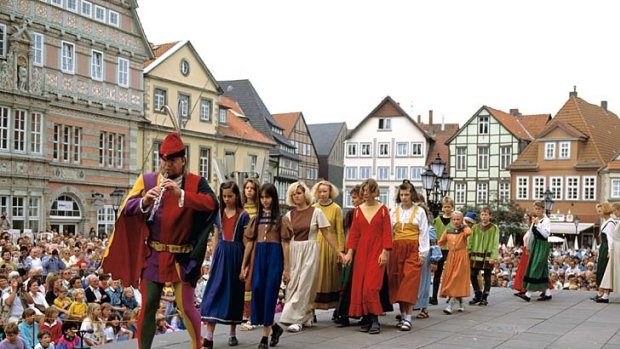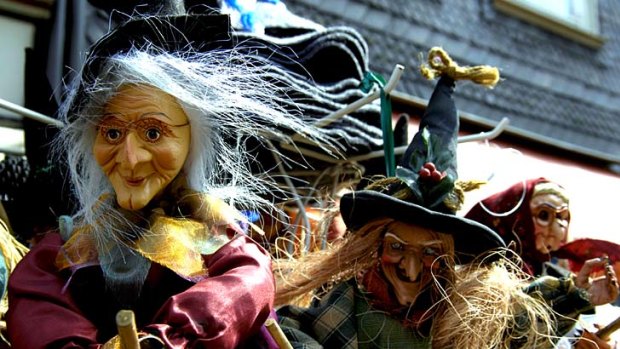
True or false ... The Pied Piper story is regularly retold in Hameln.Credit: Alamy
Julie Miller falls into a land of make-believe and twisted tales on the Fairy Tale Road of central Germany.
The last thing I feel like doing, after an interminable 24-hour flight, a two-hour train trip and a one-hour drive, is to follow in the footsteps of a man dressed in multicoloured tights and playing a clarinet. But like a child from the German folk legend The Pied Piper, that's exactly what I'm doing, obediently allowing an eccentric jester to lead me into oblivion.
Inappropriately shod in ballet flats on rain-soaked cobblestones, I slip and stumble along with my fellow rats, drawn through the picturesque streets of Hameln by a centuries-old mystery of some missing children, a plague of rodents and a stranger who created a scandal.

Witch puppets for sale in Goslar.Credit: Alamy
With a waning population of 60,000 people, the beautiful town of Hameln - 47 kilometres from the city of Hanover in central Germany - owes its existence largely to the famous rat catcher story, which dates from the 13th century.
For those unfamiliar with the tale, recounted over the years by Goethe, Robert Browning and, of course, the Brothers Grimm, it goes something like this: in 1284, a strange man appeared in Hameln, dressed in colourful garb and claiming to be a whiz at catching rats. But instead of poison or a trap, the odd little man produced a pipe, luring the rats and mice out with his tunes. He then led the music-loving rodents to a terrible death in the Weser River.
When payment wasn't forthcoming, however, the piper vowed revenge; and several months later he returned, once again letting music ring forth from his flute. Only this time, it was the town's children who followed him, out of the village and into the mountains. They were never seen again.
Hameln is not the only town ... where fact and fiction collide.
But is the story true, or just another fairytale spawned by a region with more than its fair share of fantastical yarns? According to town records, a rat catcher did indeed make an appearance in the town at that time; and a number of children were known to have disappeared. Some historians believe the piper was a paedophile, while others say the town was simply a victim of an economic downturn, the youngsters leaving to colonise parts of eastern Europe.
Whatever the truth, the story is undeniably the lifeblood of contemporary Hameln. From souvenir shops to cafes, museums to artistic performances, the town is crawling with rats. There are colourful rat statues on every corner, while a carillon featuring a mechanical piper leading a pack of rats sounds three times a day. There are little white rats painted on the footpaths, indicators of a self-guided tour; there are even bottles of potent moonshine on sale, appropriately called Rattenkiller.
The whole town is rodent crazy, especially on Sundays when everyone gets involved in a free dramatic production of The Pied Piper, featuring local children dressed as rats. And then there's the town mascot - the colourful Piper himself, played by American-born but long-term resident of Hameln Michael Boyer.
Recruited in 1994, Boyer certainly takes his role seriously, never breaking character during our 90-minute tour. He also reveals an encyclopaedic knowledge of the event and town history, quoting obscure texts and sources as he leads us through the park, along tiny alleyways and grand squares lined with ornamental Weser Renaissance structures dating from the early 17th century, and finally to St Nikolai church, where a replica of the original stained-glass window dating from the 13th century references the bizarre story.
Hameln is not the only town in this part of Germany, however, where fact and fiction collide. It is just one of 50 stops on a 600-kilometre route called the Fairy Tale Road, where the characters of the Brothers Grimm still hold sway in quaint mediaeval towns. Beginning in Hanau, a little town just outside Frankfurt where the literary brothers were born in 1785 and 1786 respectively, the route winds north through the forests of Schwalm, where Little Red Riding Hood was believed to have met the wolf, before arriving in Kassel, where the brothers lived as teenagers.
Nearby, the town of Hannoversch Munden (usually abbreviated to Hann. Munden), on the confluence of the rivers Werra, Fulda and Weser, is one of the best-preserved mediaeval towns in Europe, with more than 700 half-timbered houses creating an evocative real-life set for a fairytale epic. Just up the road is the university town of Gottingen, where the Brothers Grimm worked, while on the fringe of the eerie Harz Mountain is the exquisite UNESCO World Heritage-designated town of Goslar, known as the haunt of witches - an association celebrated each spring on Walpurgis Night, a traditional get-together of Wiccans.
The tranquil town of Trendelburg - decorated with lanterns depicting fairytale scenes - is dominated by a large round tower, said to be where Rapunzel let down her hair. Further north, you can visit Bodenwerder, the home of the eccentric historic character Baron von Munchausen, before completing the route in the northern German town of Bremen, home to animal musicians that outsmarted a pack of thieves.
With a cast of hags on broomsticks, evil queens, conniving animals and stupid children, the dark and twisted stories recounted by Wilhelm and Jacob Grimm may not seem like the perfect fodder for a family tour, but a drive along Germany's Fairy Tale Road is guaranteed to delight the child in everyone, young and old.
Trip notes
Getting there
Etihad has daily flights to Frankfurt via Abu Dhabi. etihad.com. Hanover is a two-hour train journey north of Frankfurt. raileurope.com.au. If driving the Fairy Tale Road, it's a 600-kilometre journey from Hanau to Bremen.
Staying there
While not exactly a fairytale castle, a good base for exploring the Lower Saxony region and the central part of the Fairy Tale Road is the Mercure Hotel in Hanover. mercure.com.
More information
deutsche-maerchenstrasse.com/en/.
Three fairytale castles near Hanover
1 Marienburg Castle Owned by the husband of Princess Caroline of Monaco, Ernst August, this impressive Gothic Revival castle was built in 1858 by the Hanoverian King George V as a present to his wife, who fantasised about living in a traditional fairytale castle. With its turrets and grand interiors, it certainly fits the bill. Guided tours of the castle are available. www.schloss-marienburg.de.
2 Buckeburg Castle Dating back to 1304 but rebuilt in the 17th century, this grand baroque palace — still owned by the house of Schaumburg — features ornate reception rooms, a beautifully restored chapel and impressive stables, with a high-dressage riding school and daily demonstrations of horsemanship. schloss-bueckeburg.de.
3 Sababurg Castle This evocative and romantic castle 100 kilometres south of Hanover, near Hann. Munden, is billed as Sleeping Beauty's castle, and with its tangle of vines and surrounding forest it's not hard to see why. You, too, can slumber here, as the castle now operates as a hotel, with a welcome ceremony hosted by no less than Sleeping Beauty and the Prince. sababurg.de.
Sign up for the Traveller Deals newsletter
Get exclusive travel deals delivered straight to your inbox. Sign up now.